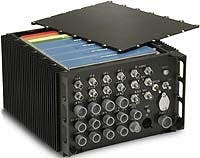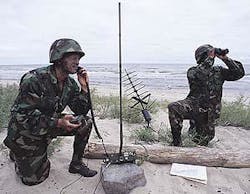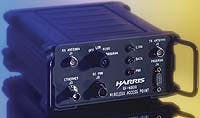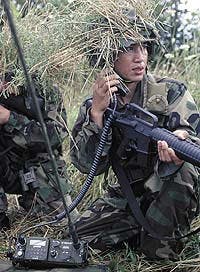By J.R. Wilson
The Joint Tactical Radio System, which is a software-defined radio, represents the newest generation of defense radios for soldiers, vehicles, ships, aircraft, and even spacecraft. This capability will enable the so-called 'JTRS' to communicate with a wide variety of new and existing communications systems, as well as help older radios network with one another.
One of the most difficult problems on battlefields throughout history has been communications. While the development of radios and modern electronics improved and simplified that effort on one level, they also severely complicated it on yet another — interoperability. The inability of different brands of radios to work together caused problems not only among coalition and allied forces, but also among the various elements of the U.S. military itself.
Since at least the 1970s, each new advance in radio technology seemed only to complicate matters further. Those using the latest SINCGARS (single channel ground and airborne radio system), for example, often were unable to communicate directly with others using the most modern satellite communications (SATCOM) system.
The extent of this problem became dramatically clear during the U.S. invasion of Grenada in October 1983. Army troops found they could not efficiently call for air support because their radios could not communicate with air and naval forces. Instead, they used personal calling cards to place international commercial telephone calls to Fort Bragg, N.C., where officials acted as intermediaries to communicate with the Air Force and Navy. Similar communications failures may have contributed to friendly fire incidents during the Persian Gulf War in 1991.
The jam-resistant, frequency-hopping SINCGARS, introduced in 1987, was the first real effort at standardization among the U.S. military services and is now employed throughout all four U.S. military services. It also was one of the first programmable radios, helping set the stage for the coming age of "software radios," a term coined in 1991 by MITRE Corp. consulting scientist Joseph Mitola III "to signal the shift from hardware intensive digital radios of the 1980s to the multiband multimode software-defined radios (SDRs) of the year 2000 and beyond."
Several new technological developments have pushed the shift to software radios, including:
- increased speed and power of embedded processors, which enables digital signal processors to perform modem functions;
- improved analog-to-digital converters, with high conversion rates and dynamic operating ranges; and
- object-oriented programming technologies, such as common object request broker architecture (CORBA) middleware, which makes software functionality independent of the underlying hardware.
"Software is probably 80 percent of the development effort of SDRs, although that is a significant 20 percent for hardware," says Manuel Uhm, senior manager for strategic marketing at software radio designer Spectrum Signal Processing in Burnaby, British Columbia. "The hardware has to be architectured in such a fashion as to support the algorithms required."
The dawn of JTRSRecognizing the speed with which these advances were being made and the impact they would have on battlefield communications, the U.S. Department of Defense (DOD) issued a mission needs statement in August 1997 for a Joint Tactical Radio System — otherwise known as JTRS. It directed the consolidation of individual service radio programs into an interoperable joint program to develop and acquire affordable, high-capacity tactical radios to meet the bandwidth needs of various echelons.The Harris AN/PRC-117F radio was originally developed for U.S. Special Forces to provide ground-to-ground, ground-to-air, and ground-to-satellite secure communications in one radio package.
"The single-function hardware design of legacy communications systems cannot take advantage of rapid changes in commercial technology and so cannot provide the functionality and flexibility necessary to achieve and maintain information superiority or to support the rapid mobility required by today's armed forces," the mission statement read. "Therefore, a software-programmable and hardware-configurable digital radio system is required to provide increased interoperability, flexibility, and adaptability to support the varied mission requirements of the warfighters. The JTR System lays the foundation for achieving network connectivity across the radio frequency (RF) spectrum and provides the means for digital information exchanges, both vertically and horizontally, between joint warfighting elements, while enabling connectivity to civil and national authorities."
That last line would become prophetic four years later when, in the aftermath of the September 11, 2001, terrorist attacks, the newly created Office of Homeland Security and others began looking at the need for assured communications among all of the private, municipal, county, state, and federal groups whose activities must coordinate to deal with disasters such as the World Trade Centers destruction.
While JTRS would support the specific and unique missions of each military service and its commands, the program focuses on joint operations among services (with allied/coalition interoperability further down the line). That would include combat and operations such as peacekeeping, training and exercises, domestic disaster relief, and humanitarian missions.
A primary requirement of DOD's Joint Vision 2020 is seamless integration of service capabilities for joint missions. JTRS will contribute to that by providing the capability to transmit, receive, bridge, and gateway between similar and diverse communications waveforms and network protocols within the RF spectrum and across service boundaries. That networking capability and multiple waveforms — including new waveforms such as wideband networking — will enable commanders and staffs to collaborate regardless of geographical and organizational boundaries.
To accomplish all these requirements, the program has eight major goals:
- common open architecture;
- multiple domains;
- multiple bands and multiple modes;
- compatibility with legacy systems;
- technology insertion to prevent obsolescence;
- tactical communications security;
- networking; and
- software re-use/common waveform software.
The sizes of two groups critical to the success of JTRS reflect the scope and complexity of the task the — the 130-plus-member Software Defined Radio Forum (SDRF) and the 950-plus-member Object Management Group (OMG). Both these groups include military and commercial representatives.
Harris offers the RF-6800 wireless access point software-defined radio for military applications.
Experts in the DOD's JTRS Joint Project Office (JPO) are responsible for developing waveforms and designing software communications architectures (SCAs), explains Air Force Col. Steven MacLaird, the JTRS program manager. Members of the Software Defined Radio Forum and the JTRS Joint Program Office chose a software communications architecture in April 2001 and nominated it as an international communications standard, MacLaird says. The current version is 2.2. "Since that time, we've run two debugging routines," he says. Last January JTRS officials formulated a request for proposals (RFP) from industry that establishes how potential contractors should move forward as they design and build the JTRS.
Leaders of the JTRS office are still deciding on which companies will build JTRS Cluster One, which is to be for ground vehicles and helicopters. Leading the Cluster One effort are officials of the U.S. Army office of tactical radio communications systems. The cluster mangers buy hardware for the environment in which they work.
Cluster Two, which U.S. Navy leaders will oversee, will involve handheld and manpack radios, while Cluster Three, also a Navy project, involves maritime and fixed-site radios. Cluster Four, which comes under the aegis of the U.S. Air Force, revolves around fixed-wing aircraft, although precisely which aircraft have not been designated. A fifth cluster, covering space, is on the drawing board. The first RFPs for clusters two and three should be ready within the next 12 to 18 months, MacLaird says.
"I have approached the Homeland Defense organization and FEMA (Federal Emergency Management Agency) with respect to our capability to help out in the homeland regime (see story page 16)," MacLaird says. "We're also discussing the program with international partners, although there are no signed MOUs at this time. There are some that are close."
The plans call for Cluster One to begin testing in 2005 and fielding in 2006. Initial operating capability for the other clusters is yet to be determined, although officials say some handhelds could be ready as early as mid-2004, depending on how the acquisition strategy evolves.
"SOCOM (Special Operations Command) has a software-defined radio today, although we have not yet determined if it is within SCA compliance. We think it may be more than 50 percent, so the question is, how do you make it more compliant," MacLaird says.
The Harris RF-5800H-MP HF/VHF Manpack tactical radio system is part of a family of software-defined radios.
The JTRS concept calls for developing waveforms in an open architecture so the waveforms can port between radios. While the JPO's approach calls for from two to eight channels in each JTRS box, the services running the cluster programs are looking at higher numbers. Thus the resulting radios are to be modular and scalable, and able to store as many as ten waveforms per box.
"The decision to store 10 was based, simplistically, on what we thought the memory and throughput capabilities would be," MacLaird says. "If you have the ability to upload and download waveforms, you can pick the ones you need for a particular scenario. That let's you do the mission of the day."
The size and function of the platform for which each is devised will drive the number of channels — perhaps four to six on a JTRS mounted on a Humvee, but more on one intended for use on a Joint Surveillance Target Attack Radar (Joint STARS) aircraft.
"Channels are different than waveforms. When you have talk channels, you have to think UHF, VHF, SATCOM, and so on. That allows for simultaneous operation and the opportunity to do what we call cross-banding, which equates to individuals talking on different waveforms," MacLaird explains. "If you have a JTRS on site, you can talk between those waveforms. For example, someone might be in SINCGARS and you could cross-band it into SATCOM. So you're talking about linkages. In some scenarios, if you have two different waveforms on site, you can't talk to each other. With JTRS, you could cross-band and connect.
"One of our tenants is we have to talk to legacy waveforms; there are 33 of those. And we have to develop a new waveform known as the wideband network (WNW). The frequency — 2MHz to 2GHz — is mandated now, but we intend to ask in March for that to be expanded, perhaps to the 4 GHz to 6 GHz range. That is where the handheld mobiles operate."
The JPO's goal, as set out in the mission needs statement, is to migrate existing radios to systems compliant with the JTRS architecture. Existing radios typically are single-band, single-mode units with limited or no networking capability. As such, they often require complex solutions to integrate older radios into networks. What complicates interoperability further is the use of proprietary hardware and waveforms. Officials say they plan to migrate older radio systems to the open systems architecture in a phased implementation that balances operational requirements, weapon system integration issues, and funding constraints.
Despite its apparent ubiquity, JTRS is not to be a one-size-fits-all system, but a family of affordable, interoperable, and scalable radios that build on their common open architecture to share waveform software, even between radios in different physical domains. Commercial-off-the-shelf (COTS) parts will play a major role in the system hardware at the component level. COTS chips, boards, and software are to enable the radios in the future to act much like desktop and portable computers do today.
Soldiers use the RF-5800H-MP to provide long-range HF voice and data communications.
"From the hardware aspect, being an open architecture, modular design is similar to the design of a PC — mainly a board, and a driver for the board," notes Phil Lai, JTRS program manager for ITT Corp. in Wayne, Ind. "The key is to reuse whatever we develop depending on the needs, and tailor it to suit the customer's requirement. That is the basic principle behind the SDR and JTRS. It will take a little time to get this effort perfected to the current state of the PC industry, which has been doing things this way for more than a decade. So we are trying to move that concept from the commercial world into the military world."
Once ITT engineers finish the JTRS design, manufacturing and repair become very easy, Lai says. As a modular approach, anything that becomes defective later on can be easily replaced at a relatively low cost.
The basic application of JTRS is to understand any signal for which it has a downloadable waveform and act as a relay/interpreter between otherwise incompatible systems. This model also holds true for PCs.
"If an e-mail comes into your computer with an attachment, you just click on it — you don't care what the format is, so long as you have the software to read it," MacLaird says. "If you have eight or ten waveforms stored in a radio and a waveform comes across the air, you don't care which it is in order to receive it."
The JTRS also acts like a computer in its capacity for rapid, in-the-field upgrading of JTRS software and hardware. JTRS will use software signal processing to handle all kinds of signals instead of dedicated, single-purpose hardware. Many standard communications functions are available off-the-shelf as software libraries that can be compiled into field programmable gate array tool to deal with whatever signal comes along.
"Because you have different processors that need to talk to each other, it is a difficult problem to solve at the subsystem design level, but all of that is transparent to the user. If a board goes out, you simply swap it out — all our new systems are hotswap. So it is simple for them, despite the work it takes at our end to design it," Uhm says.
"On the technology front, the evolution in processors and things like switched fabric interconnects have come a long way very recently to make the actual implementation of an SDR possible and to make it smaller and more portable. But the technology certainly exists today to support the requirements of JTRS. But there are still a lot of factors preventing SDR from worldwide deployment. Many of those are political or regulatory."
Software-defined radio is just beginning to hit its strideU.S. military and industry experts are developing the Joint Tactical Radio System (JTRS) as an architectural definition for a software-defined radio. Versions of software-defined radios already are in use by the U.S. military. In simple terms, JTRS will be an advanced version of these software-driven devices.By definition, users can quickly reprogram a software-defined radio to transmit and receive on any frequency within a wide range using virtually any transmission format. Functions that hardware normally handles, such as generating a transmitted signal and tuning and detecting a received signal, come under control of software and high-speed signal processors.
The software-defined radio is designed to be quickly and easily reprogrammed, and operates over a broad range of frequencies, bandwidths, and transmission standards. That means one device, properly programmed, could operate in all the various military, emergency services, cellular, PCS, and other wireless modes used in the United States and worldwide.
Software controls the radio's technical characteristics such as operating frequencies and output power. This design approach also may enable these radios to improve spectrum efficiency and spectrum sharing. By monitoring the spectrum for use by other parties, for example, a software-defined radio could locate and transmit on an available open frequency, and in the process provide greater flexibility in using the full spectrum.
Several manufacturers are producing software-defined radios for a variety of applications. Harris Corp. in Rochester, N.Y., for example, has built a family of software defined digital radios, under the Falcon II label. These radios cover different frequency bands. The AN/PRC-117F Multiband/Multimission Radio, currently in use by all the U.S. military services, is a 30-to-512 MHz-band radio that incorporates several different software-defined waveforms, such as SINCGARS, HaveQuick, and old Type 1 encryption modes.
Cooperative research in the U.S., Japan, South Korea, Germany, and the United Kingdom is rapidly advancing the technology, according to the Software Defined Radio Forum (SDRF), a global non-profit organization comprising about 100 suppliers, manufacturers, end users, regulatory agencies, and universities. This, SRDF officials say, will enable:
- end-users to realize "true" choices with "pay as you go" features, device independence, and a single piece of scalable hardware that is at once compatible at a global scale;
- network operators to differentiate their service offerings without supporting many different handhelds and to move to adjacent markets as well as offer new, tiered services to increase their revenue mix;
- infrastructure suppliers to lower cost and insure themselves against price-erosions through concentrated efforts on a common hardware platform and reduced component counts;
- applications developers to enhance value without concern to hardware types; and
- terminal providers to add features, patches and capabilities to devices for broader market participation.
Officials of the U.S. Department of Defense (DOD) created the Joint Tactical Radio System (JTRS) program to provide a single software-defined radio (SDR) that could stand as the universal translator for all other incompatible military communications systems. Those working on JTRS and other software-defined radios say they believe the same technology could apply to civil and private emergency services requirements as part of the Homeland Defense effort.
"There is an effort being mounted for a JTRS approach within the U.S. to unify the communications for emergency services. That apparently has gotten some initial approval," says Rodger Hosking, vice president of software radio maker Pentek Inc. in Upper Saddle River, N.J.
"In many cases, the concept may be the same, but the implementation would be done at a different level," Hosking says. "Municipalities might not have quite the specs of a military radio system, but they do see value in the concept of a capable and configurable front-end tunable over a wide range of frequencies, digitizing those, and bringing them down to a computer platform that can be configured for everything from cell phones to fire, police, ambulance, and all other signals that might arise in an emergency.
"So it does cross over, even to commercial wireless," Hosking says. "There is no longer a great disparity in the level of complexity between government and commercial communications systems. That has put considerable demand on the signal-processing capabilities of both civilian handsets and base stations that rivals or exceeds that of military systems. A municipal radio capability where 911 calls could go directly to a municipal radio and not have to rely on a traditional service provider, such as Verizon or Sprint, is part of what this initiative should be doing."
The JTRS concept also may apply to the war on terrorism outside the United States by non-military agencies, such intelligence experts who monitor cell phone activity in areas where U.S. officials suspect terrorist activities.
"The question is, what are the tactical needs of our forces around the world and what do we need to do at home in terms of homeland security — and how do those mesh," Hosking says. "The only way to do that is to make those systems adaptable and configurable so they can identify the signals they need to deal with and then use software to modify the system to talk to those systems. All that is very DSP [digital signal processing] intensive and more and more of it is being done in configurable logic as opposed to dedicated logic.
"Another thing we've been hearing about is the 911 system itself, in terms of the ability to do direction finding with regard to cell phones," Hosking continues. "We've been talking to customers for several years who have been chasing that, trying to triangulate signals from the towers. That also could be of vital interest in a national emergency, being able to locate the source of emergency calls."
The solution for bringing together the vast variety of standards in both the civil and military communications worlds — in the U.S. and overseas — lies at the heart of JTRS and other advanced software-defined radios. They key is the software radio's common platform and software, augmented by specialized algorithms.
For widespread application, that would require identifying all of the necessary waveforms and creating an available library, then determining the size of memory required for individual radios — especially handhelds — in order to handle multiple waveforms. Less memory would be required if the unit was able to detect and identify a new signal, then download the required waveform on the fly.
This approach, however, will not come to pass overnight. "An actual physical JTRS radio is some years away," admits Kevin Kane, director of business development for U.S. ground forces at the Harris RF Communications Division in Rochester, N.Y. If a software radio were in production today as originally conceived, "you would be able to use it as a retransmission site for multiple agencies [in a terrorist attack response mode," Kane says.
Federal officials have identified a waveform for the federal over-the-air interoperability standard, called APCO-25, to deal with several different civilian law-enforcement agency and emergency services radios on the federal, state, and local levels. JTRS, however, "is not currently planned to include that. Once JTRS reaches more mature technical levels, there's no reason it could not be incorporated into the system," Kane says.
Applications such as homeland defense would require encryption keys to prevent signal interdiction or spoofing, even for units with the necessary waveform. Operators could exchange encryption keys on secure links, as necessary, and change them periodically, depending on the level of security required.
"You also could set up groups of JTRS radios that only could communicate with each other and not outside that group, creating a cell of users, perhaps only one member of which could communicate outside that cell for enhanced security," Hosking adds.
Yet there is a dark flip side to the security that software-defined radios offer to military and domestic security applications, warns Manuel Uhm, senior manager for strategic marketing at software radio designer Spectrum Signal Processing in Burnaby, British Columbia. "The flexibility of SDR also would make it easier for terrorists to have secured communications," he says. "Right now, the technology isn't there for them to have the portability they probably want."
Still, the versatility of the software-defined radio may raise problems with allies, as well. "Old hardware radios could only support a very defined bandwidth you were authorized to use, but an SDR can access any bandwidth in the spectrum, which makes things difficult for governments to regulate," Uhm says. "Even allies like the United Kingdom will not be thrilled with U.S. forces coming in with SDRs that are free of restraints," he warns. "Encryption is a key element of SDR — to how you ensure it will operate within the parameters governments want them to operate in. In essence, you are trying to limit the capabilities of an SDR."
Cost is also a factor — ironically, probably more so for civil emergency services agencies than for well-funded terrorist organizations such as al-Qaida. While software-defined radio technology is available to the commercial buyers, its cost has not low enough to attract commercial customers.
In simple terms, despite its advantages, it is not yet cost-effective compared to existing fixed-function radios. That may be another spur-to-the-hub concept for emergency services — one or more software-defined radios on the infrastructure side, communicating with existing radios, with handsets coming along later.
But that approach also may speed along eventual commercial availability, Uhm notes: "When you talk about emergency services, it gets much closer to the commercial requirement, where you have price sensitivity, but also a very large market. That would drive economies of scale and make SDRs much more affordable across a broader spectrum of users."






